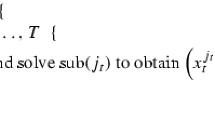Abstract
In this paper we present a method of pricing catastrophe bonds (cat bonds) using stochastic programming. Stochastic programming is a method ubiquitous in operations research when decision problems involve uncertainty. We demonstrate the method for pricing cat bonds which bypasses the need to define the equivalent martingale measure or estimate the market price of risk. The price of the cat bond is simply the coupon that needs to be paid that attains a specified return on investment given a set of constraints that define the payoffs.


Source BMA ILS market report




Similar content being viewed by others
Notes
By subjective we mean preference-based using a utility function.
We will use the term insurer and reinsurer interchangeably unless noted otherwise.
The variance of the average loss goes to zero with more insured units.
When an insurance event occurs, most likely cat bonds will have their collateral wiped out.
We assume that all money of the SPI is invested into risk-free assets.
If we were maximizing the coupon given a constraint of a minimum RoI, the value of the coupon would be infinite.
References
Aase K (1999) An equilibrium model of catastrophe insurance futures and spreads. Geneva Pap Risk Insur Theory 24:69–96
Birge RJ, Louveaux F (2011) Introduction to stochastic programming, 2nd edn. Springer, New York
Branda M (2014) Optimization approaches to multiplicative tariff of rates estimation in non life insurance. Asia Pac J Oper Res 31(5):1450032
Dassios A, Jang J (2003) Pricing of catastrophe reinsurance and derivatives using the Cox process with shot noise intensity. Finance Stoch 7:73–95
Dickson D (2010) Insurance risk and ruin. Cambridge University Press, Cambridge ISBN 978-0-521-17675-0
Geman H, Yor M (1997) Stochastic time changes in catastrophe option pricing. Insur Math Econ 21:185–193
Heckman P, Meyers G (1983) The calculation of aggregate loss distributions from claim severity and claim count distributions. In: Proceedings of the casualty actuarial society, LXX, 22–61
Hochreiter R, Pflug G, Paulsen V (2008) Design and management of unit-linked life-insurance contracts with guarantees. In: Handbook of asset and liability management, vol 2, Chapter 14, pp 627–662. Elsevier, North-Holland
Kall P, Wallace WS (1994) Stochastic programming. Wiley, Chichester
Muermann A (2001) Pricing catastrophe insurance derivatives. In: Financial markets group and the Wharton school, Discussion Paper No, p 400
Author information
Authors and Affiliations
Corresponding author
Ethics declarations
Conflict of interest
The author states no conflict of interest.
Additional information
The content of this paper reflects the views of the author and not of the BMA.
Rights and permissions
About this article
Cite this article
Georgiopoulos, N. Pricing catastrophe bonds with multistage stochastic programming. Comput Manag Sci 14, 297–312 (2017). https://doi.org/10.1007/s10287-017-0277-6
Received:
Accepted:
Published:
Issue Date:
DOI: https://doi.org/10.1007/s10287-017-0277-6




